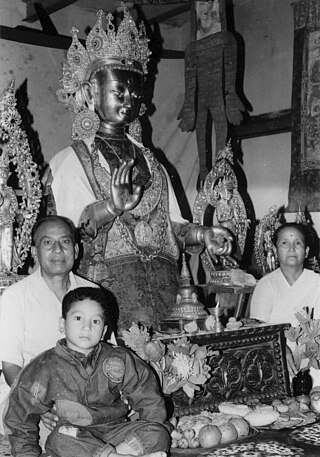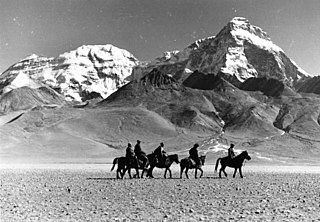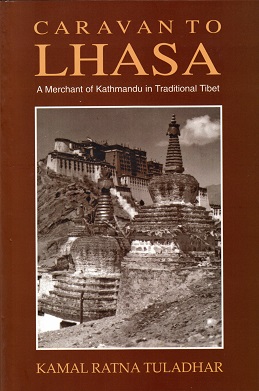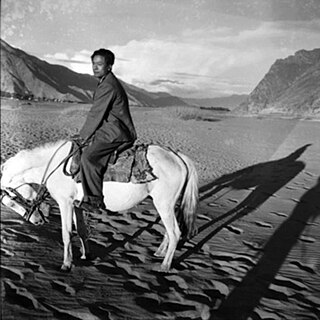
Newar, or Nepami, are primarily inhabitants in Kathmandu Valley of Nepal and the Indian territories of Sikkim state and Gorkhaland including its surrounding areas and the creators of its historic heritage and civilisation. The Newar are a distinct linguistic and cultural group, primarily Indo-Aryan and Tibeto-Burman ethnicities, who share a common language, Nepal Bhasa, and predominantly practice Newar Hinduism and Newari Buddhism. Newars have developed a division of labour and a sophisticated urban civilisation not seen elsewhere in the Himalayan foothills.

Chittadhar Hridaya was a Nepalese poet. He is regarded as one of the greatest literary figures from Nepal in the 20th century.

Tulādhar is a Nepali/Nepalese caste from the Newar community of the Kathmandu Valley in Nepal. The name Tuladhar is derived from the Sanskrit words "tula" and "dhar" (possessor), thus meaning scale-bearer or in general, merchant. Tuladhars belong to the Uray group which includes Kansakar, Tamrakar, Sthapit, Bania, Sindurakar, Selalik and other castes. They follow Newar Buddhism and speak Nepal Bhasa as a mother tongue.

Karuna Ratna Tuladhar was a pioneer of Nepalese public transport. He was proprietor of Nepal Transport Service which he and his brother Lupau Ratna Tuladhar founded in 1959. This was Nepal's first public bus service which linked the capital Kathmandu with the railhead of Amlekhganj, 190 kilometers to the south near the Indian border.

Nepal Transport Service was the first, and for a time, the largest, Nepalese public bus line. The company was based in the capital Kathmandu and operated from 1959 to 1966. Its head office was located at 122 Asan Tyouda Tol, Kathmandu.

Dharma Man Tuladhar was a Nepalese trader and philanthropist best known for the renovation of the Swayambhu stupa in Kathmandu, one of the holiest Buddhist shrines in Nepal.

Pushpa Sundar Tuladhar was a prominent merchant of Kathmandu and one of the chief donors to the restoration of the Swayambhu stupa in 1918. Swayambhu, a UNESCO World Heritage Site, is one of the holiest Buddhist shrines in Nepal and the center of Newar Buddhism. The renovation project was headed by his father-in-law Dharma Man Tuladhar and completed in 1921.

Thaunkanhe is the first magazine in Nepal Bhasa to be published from Nepal. The monthly magazine began publication on 21 May 1951, coinciding with the festival of Swanya Punhi, the "full moon day of flowers" marking the anniversary of the Buddha's birth, enlightenment and nirvana. It was among the very few magazines published in Nepal at the time.

Lhasa Newar refers to the expatriate Newar traders and artisans who traveled between the Kathmandu Valley and Tibet from centuries ago. These Nepalese merchants conducted trade between Nepal, Tibet and Bengal, India over the Silk Road, and acted as a bridge for economic and cultural exchanges between South Asia and Central Asia.

Pushpa Ratna Sagar was a Nepalese merchant, grammarian, lexicographer and pioneer pressman. Born Pushpa Ratna Tuladhar in Asan Dhalasikwa, Kathmandu, he acquired the nickname Sagar in his childhood during a pilgrimage to Ganga Sagar in India. He was the third and youngest son of trader Pushpa Sundar Tuladhar and his wife Dhan Maya.

Kansakār or Kasāh (कसाः) is a Nepalese caste group belonging to the Newar community of the Kathmandu Valley in Nepal. In Sanskrit, Kansakar means bronze worker, and their traditional occupation has been metal working and trading. Today, they are merchants, industrialists and professionals.

Lupau Ratna Tuladhar was a Nepalese trader and transport pioneer. He and his brother Karuna Ratna Tuladhar established Nepal Transport Service in 1959 and operated the first regular bus service in Nepal.

Purna Kaji Tamrakar was a Nepalese merchant, author and journalist who worked to develop Nepal Bhasa at the time when writers were being persecuted by the government.

Singha Sārtha Aju is a merchant in Nepalese folklore. According to tradition, he is the first Newar merchant of Kathmandu to travel to Tibet, and his story is one of the most loved legends in Newar society. Singha Sartha is also considered to be a previous incarnation of the Buddha.

Triratna Man Tuladhar (1905-1986) was one of the largest Nepalese traders in traditional Tibet and the president of the Nepalese Chamber of Commerce, Lhasa in the 1940s.

Urāy is a Newar Buddhist merchant caste of Kathmandu in Nepal. They are a prominent community in the business and cultural life of Kathmandu. Urays have played key roles in the development of trade, industry, art, architecture, literature and Buddhism in Nepal and the Himalayan region.

Caravan to Lhasa is a travel book and an account of the lives of expatriate Nepalese merchants in Lhasa from the 1920s to the 1960s. Written by Kamal Ratna Tuladhar, the book describes the caravan journey from Kathmandu across the Himalaya, and the life and times of the Newar traders in Tibet through the experiences of his merchant father Karuna Ratna Tuladhar (1920-2008) and uncles.

Bhāju Ratna Kansakār was a Nepalese trader and philanthropist who laid the foundations of the Jyoti Group, one of the largest business and industrial houses in Nepal. He was also an important figure in the revival of Theravada Buddhism in the country when it was being suppressed by the state.

Bhakta Bir Singh Tuladhar was a Nepalese merchant and philanthropist. He held a special Samyak (सम्यक) ceremony in 1952 when the country was passing through a political crisis, and the Buddhist alms-giving festival became of crucial importance for both sides in the power struggle.

Pratek Man Tuladhar (1924–1991) was a Nepalese trader and philatelist. Born in Kathmandu into a family of hereditary merchants, he spent his youth in Lhasa, Tibet, where they owned a business house.





















